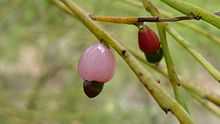Exocarpos strictus
| Pale-fruit Ballart | |
|---|---|
 | |
| Scientific classification | |
| Kingdom: | Plantae |
| (unranked): | Angiosperms |
| (unranked): | Eudicots |
| (unranked): | Core eudicots |
| Order: | Santalales |
| Family: | Santalaceae |
| Genus: | Exocarpos |
| Species: | E. strictus |
| Binomial name | |
| Exocarpos strictus R.Br. | |
Exocarpos strictus (Common name Pale-fruit Ballart) is an adaptably versatile, densely thicketing, erect shrub bearing cherry-like fruit, that is native to parts of Australia (including Tasmania). It is sometimes also referred to as the Dwarf Cherry, a name more commonly used for Prunus fruticosa or Prunus pumila, true cherries.[1] E. strictus was described by botanist Robert Brown in 1810.
Branches and leaves
Though often hairy early on, E. strictus' branches typically become fine and vertical; occasionally they become either stout or long (rarely above 3.5 m) and bending downward with the weight of their foliage and/or fruit.[1]
Its leaves are 1 – 3 mm in length, caducous, linear, subulate, and vary in color from light green to a bluish-green, and ashy to bronze[1]
Flowers
The flowers of E. strictus grow in little pedunculate or sessile clusters numbering 2 - 6. They have 4 or 5, triangular, tepals that measure about 0.5 mm long. The pedicel is 2 – 7 mm long, succulent, broadly obovoid, and colored either mauve, red, or white.[1]
E. strictus flowers all year round.[2]
Fruit
The fruit of E. strictus superficially resemble stunted cherries. They are drupes measuring 2.5 – 4 mm, are ovoid or globose, shiny, and green to purple-black in coloration.[1]
Distribution and occurrence
E. strictus grows in great numbers in all but the very wettest and driest of habitats ranging from heathland to open forests to denser woodland.[2]
It is common in Victoria, South Australia, Queensland, New South Wales, Tasmania and the Australian Capital Territory[1]
References
- ↑ 1.0 1.1 1.2 1.3 1.4 1.5 B. Wiecek; National Herbarium of New South Wales staff (1992 ). "Exocarpos strictus Herbarium Sheet". PlantNET - The Plant Information Network System of Botanic Gardens Trust, Sydney, Australia. Retrieved 18 May 2009.
- ↑ 2.0 2.1 Percival St. John, Grimwade Plant Collection. "Factsheet - Exocarpos strictus". Dr Alison Kellow, Dr Michael Bayly, Prof. Pauline Ladiges. University of Melbourne . Retrieved 18 May 2009.
External links
- Australian Plant Image Index has a picture of Exocarpos strictus